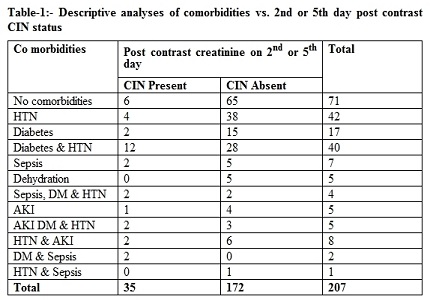Identification of Contrast Induced Nephropathy (CIN) with intravenous iso-Osmolar contrast media in renal failure patients with and without additional comorbidities undergoing Computed Tomography
Abstract
Aim: To identify contrast induced nephropathy with intravenous iso-osmolar contrast media in renal failure patients with additional comorbidities undergoing computed tomography.
Study design: Hospital based observational study.
Methods: A retrospective study was conducted on 207 patients with pre-existing renal failure and comorbidities. In this study we collected pre-contrast creatinine values available within 3 weeks and post-contrast creatinine value was collected on 2nd and 5th day following CM injection in order to check early and late contrast induced nephropathy (CIN). Rate of CIN with and without comorbid conditions in CKD patients were calculated. Then we assessed the incidence of CIN with different amount of CM administered. We also calculated the relation of CIN with pre-contrast creatinine and eGFR range, which was categorized as 1.4- 2.0 mg/dL, 2.0-3.0 mg/dL and >3 mg/dL and >60ml and <60 mL/min per 1.73 m2 respectively.
Results: Rate of CIN was relatively higher in renal failure patients and also in patients with comorbidities especially diabetes mellitus. Risk of CIN development was possible on 5th day also which was considered as delayed CIN. It was shown in the study that as the amount of contras media increases, rate of CIN also increases which was prominent in case of patients administered with >80ml of contrast media. CIN risk was better determined by eGFR than Creatinine value.
Conclusion: CIN rate was clinically significant in CKD patients with comorbidities who received an iso-osmolar contrast media.
Downloads
References
Groell R, Doerfler O, Schaffler GJ, Habermann W. Contrast-enhanced helical CT of the head and neck: improved conspicuity of squamous cell carcinoma on delayed scans. AJR Am J Roentgenol. 2001 Jun;176(6):1571-5.doi: https://doi.org/10.2214/ajr.176.6.1761571.
What are contrast materials and how do they work ? Radiologyinfo.org:2014;1–8.
Mccullough PA, Bertrand ME, Brinker JA, Stacul F. A Meta-Analysis of the Renal Safety of Isosmolar Iodixanol Compared With Low-Osmolar Contrast Media. J Am Coll Cardiol. 2006 Aug 15;48(4):692-9. Epub 2006 Jul 24.2006;48(4). DOI: https://doi.org/10.1016/j.jacc.2006.02.073.
Choi D, Oh B, Lee M, Park Y. Renal Toxicity Evaluation and Comparison Between Visipaque ( Iodixanol ) and Hexabrix ( Ioxaglate ) in Patients With Renal Insufficiency Undergoing Coronary Angiography. J Am Coll Cardiol. 2006 Sep 5;48(5):924-30. Epub 2006 Aug 17. DOI: https://doi.org/10.1016/j.jacc.2006.06.047.
Aspelin P, Aubry P, Fransson S-G, Strasser R, Willenbrock R, Berg KJ, et al. Nephrotoxic effects in high-risk patients undergoing angiography. N Engl J Med [Internet]. 2003 Feb 6 [cited 2016 Jun 29];348(6):491–9. DOI: https://doi.org/10.1056/NEJMoa021833.
Trial ARD, Nephropathy C, Solomon RJ, Natarajan MK, Doucet S, Sharma SK, et al. Cardiac Angiography in Renally Impaired Patients (CARE) Study Patients With Chronic Kidney Disease. Circulation. 2007;115:3189- 3196 http://dx.doi.org/10.1161/CIRCULATIONAHA.106.671644.
AR, Kuhn MJ, Chen N, Beek EJR Van, So GJ. The PREDICT study: a randomized double-blind comparison of contrast-induced nephropathy after low- or isoosmolar contrast agent exposure. AJR Am J Roentgenol. 2008 Jul;191(1):151-7. doi: https://doi.org/10.2214/AJR.07.3370.
Nguyen SA, Suranyi P, Ravenel JG,, Randall PK, Romano PB, Strom KA, Costello P, Schoepf UJ. Iso-osmolality versus low-osmolality iodinated contrast medium at intravenous contrast-enhanced CT: effect on kidney function.Radiology. 2008 Jul;248(1):97-105. doi: https://doi.org/10.1148/radiol.2481071484. Epub 2008 May 15.
Thomsen HS1, Morcos SK.. Risk of contrast-medium-induced nephropathy in high-risk patients undergoing MDCT – A pooled analysis of two randomized trials. Eur Radiol. 2009 Apr;19(4):891-7. doi: https://doi.org/10.1007/s00330-008-1206-4. Epub 2008 Nov 11.
Heinrich MC1, Häberle L, Müller V, Bautz W, Uder M.. Nephrotoxicity of Iso-osmolar Nonionic Low-osmolar Contrast Controlled Trials, Radiology: 2009 Jan;250(1):68-86. doi: https://doi.org/10.1148/radiol.2501080833.
Hernández F, Mora L, García-tejada J, Velázquez M, Gómez-blázquez I, Bastante T, et al. Comparison of Iodixanol and Ioversol for the Prevention of Contrast-Induced Nephropathy in Diabetic Patients After Coronary Angiography or Angioplasty. Rev Esp Cardiol. 2009 Dec;62(12):1373-80. DOI: http://dx.doi.org/10.1016/j.rec.2016.05.033.



 OAI - Open Archives Initiative
OAI - Open Archives Initiative


